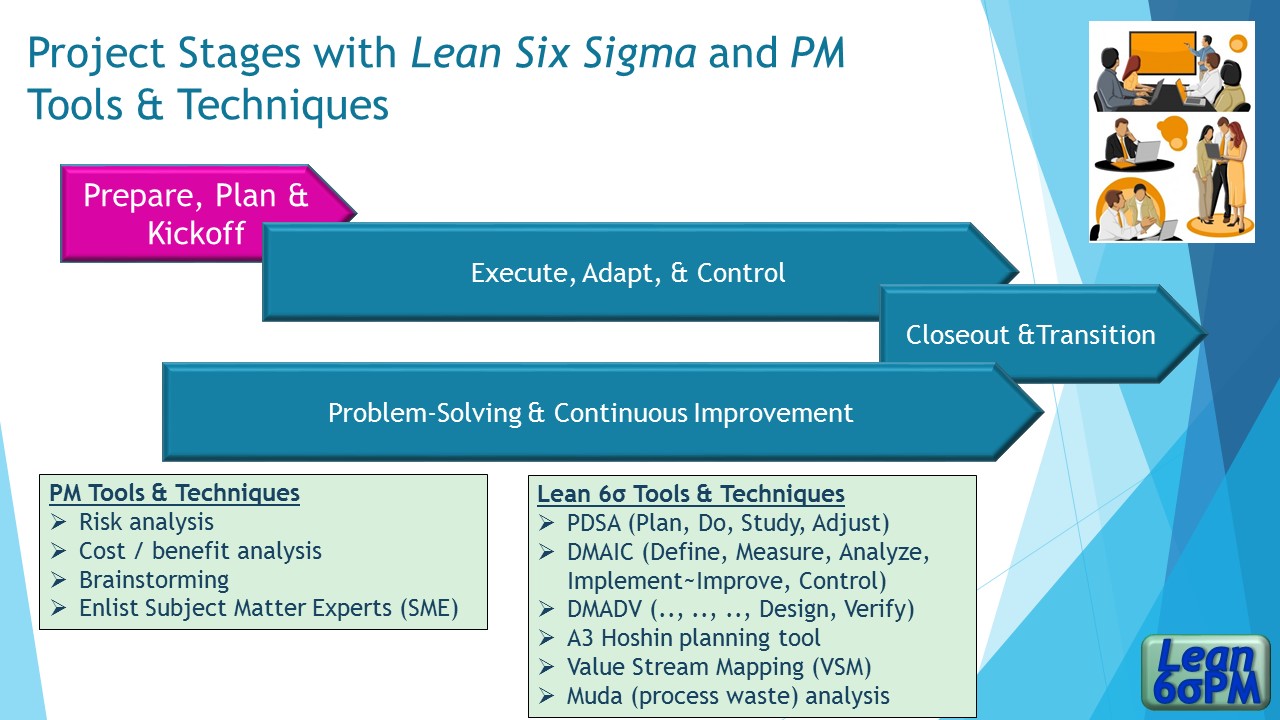Prepare; Project Plan; Project Kickoff

The Needs of the Business Inspire a New Project
Preparation and planning are as much characteristic of the business environment as they are actual phases of a given program or project. Manufacturing operations and product engineering often involve multi-year programs with many overlapping and sequential projects to achieve the business’s long-term objectives –profitability, technology leadership, field performance, warranty costs, customer base, market share, and others.
High level business strategy around those objectives translates to product and process technology ‘roadmaps’ that define the necessary or desired direction for functions and for the overall value stream, at least for evolutionary products. These strategic activities make use of divergent (“blue sky”) thinking, attempting to forecast what might be demanded by customer and market needs 2 to 4 years in the future, without necessarily knowing if or how those needs can be met.
When the business strategy and roadmaps reveal a gap to be addressed, or an unmet market opportunity, or the need for a process breakthrough in order to capitalize on a perceived need, planning moves from strategic to tactical and a specific project definition starts to take shape. Tactical planning makes use of convergent (focused) thinking among all known stakeholders as considerations of scope, budgetary costs, desired ROI, boundary conditions, constraints, and risks, become the important factors leading to a decision to define a specific project.
Once the relevant questions have been asked and answered, and the project plan has solidified through iterative challenges and PDSA cycles, then what? An upbeat, meaningful, and informative project kickoff event is a good method for bringing all the stakeholders together to ensure they are aligned on the tactical project plan baseline. In the poignant words of The Rolling Stones, it’s time to “Start Me Up!”
Preparation and planning are as much characteristic of the business environment as they are actual phases of a given program or project. Manufacturing operations and product engineering often involve multi-year programs with many overlapping and sequential projects to achieve the business’s long-term objectives –profitability, technology leadership, field performance, warranty costs, customer base, market share, and others.
High level business strategy around those objectives translates to product and process technology ‘roadmaps’ that define the necessary or desired direction for functions and for the overall value stream, at least for evolutionary products. These strategic activities make use of divergent (“blue sky”) thinking, attempting to forecast what might be demanded by customer and market needs 2 to 4 years in the future, without necessarily knowing if or how those needs can be met.
When the business strategy and roadmaps reveal a gap to be addressed, or an unmet market opportunity, or the need for a process breakthrough in order to capitalize on a perceived need, planning moves from strategic to tactical and a specific project definition starts to take shape. Tactical planning makes use of convergent (focused) thinking among all known stakeholders as considerations of scope, budgetary costs, desired ROI, boundary conditions, constraints, and risks, become the important factors leading to a decision to define a specific project.
Once the relevant questions have been asked and answered, and the project plan has solidified through iterative challenges and PDSA cycles, then what? An upbeat, meaningful, and informative project kickoff event is a good method for bringing all the stakeholders together to ensure they are aligned on the tactical project plan baseline. In the poignant words of The Rolling Stones, it’s time to “Start Me Up!”
When it's time to take Action --

Successful implementation in the Prepare, Plan, and Kickoff stage (or any stage) requires focus on the one, two, or maybe three, most important actions that need to be taken.
The previous manager of one of the product engineering teams I led had a sign posted outside his office to “motivate the team.” It read:
We have to focus on everything!
Apparently, the irony of that statement was lost on him… I took down the sign on my first morning as their new manager, with applause from the team, and then began setting a new direction for the engineers’ project work.
Focus requires asking the right questions of the project team, customers, and business leaders, and then working to act on them in a deliberate manner. The questions at this stage are intended to probe the specific business, program, and product or process characteristics that ultimately lead to the scope for the project.
Go for Extraordinary!
The Project Management Institute’s PMBOK® provides a set of typical planning questions to guide the professional PM. They center on topics such as:
♦ Resource needs
♦ Risk assessment
♦ Budget and funding sources
♦ Stakeholder assessment
♦ Communication plan
Questions around these topics should be asked and considered thoughtfully by project team members, and used as the basis of drafting the project plan, charter, schedule, and associated documents. This level of focused attention during planning is sufficient for most project managers to lead the team through the remaining project stages to successful completion.
Successful completion is good enough for 85-90% of PM’s and their executive leadership.
For exceptional project managers and business leaders, the top 10% or so who refuse to settle for good enough, there is a deeper set of questions not found in the PMBOK®.
Such exceptional leaders press for even greater results, whether for incremental product improvements or breakthrough performance that leads to significant new business. Their questions arise from regarding the portfolio of projects and programs as if they are products or processes unto themselves. They derive from the lean six sigma framework called PDSA, for Plan-Do-Study-Adjust.
Why lead the project using the deeper set of PDSA-inspired questions? For the exceptional project leaders, the job is not only to complete the project, but to improve the process of running projects. Furthermore, business longevity demands development of the hard and soft skills of the team members so that over the course of several projects, the business grows new leaders.
Question: Which would you rather say at the close of your project?
a) We finished the ‘Antares’ project on time and under budget!
— or —
b) We finished on time and under budget! We perfected a method all our future projects can use to streamline qualification! Additionally, 2 of the ‘Antares’ team members have been promoted to Project Manager and are now leading new projects!
Hint: Choose b).
Ping me, Dann@Lean6sigmaPM.com, to find out how to employ PDSA questions when preparing and planning your new project.
The Project Management Institute’s PMBOK® provides a set of typical planning questions to guide the professional PM. They center on topics such as:
♦ Resource needs
♦ Risk assessment
♦ Budget and funding sources
♦ Stakeholder assessment
♦ Communication plan
Questions around these topics should be asked and considered thoughtfully by project team members, and used as the basis of drafting the project plan, charter, schedule, and associated documents. This level of focused attention during planning is sufficient for most project managers to lead the team through the remaining project stages to successful completion.
Successful completion is good enough for 85-90% of PM’s and their executive leadership.
For exceptional project managers and business leaders, the top 10% or so who refuse to settle for good enough, there is a deeper set of questions not found in the PMBOK®.
Such exceptional leaders press for even greater results, whether for incremental product improvements or breakthrough performance that leads to significant new business. Their questions arise from regarding the portfolio of projects and programs as if they are products or processes unto themselves. They derive from the lean six sigma framework called PDSA, for Plan-Do-Study-Adjust.
Why lead the project using the deeper set of PDSA-inspired questions? For the exceptional project leaders, the job is not only to complete the project, but to improve the process of running projects. Furthermore, business longevity demands development of the hard and soft skills of the team members so that over the course of several projects, the business grows new leaders.
Question: Which would you rather say at the close of your project?
a) We finished the ‘Antares’ project on time and under budget!
— or —
b) We finished on time and under budget! We perfected a method all our future projects can use to streamline qualification! Additionally, 2 of the ‘Antares’ team members have been promoted to Project Manager and are now leading new projects!
Hint: Choose b).
Ping me, Dann@Lean6sigmaPM.com, to find out how to employ PDSA questions when preparing and planning your new project.
